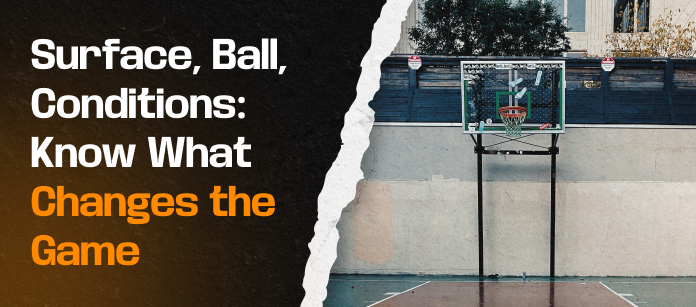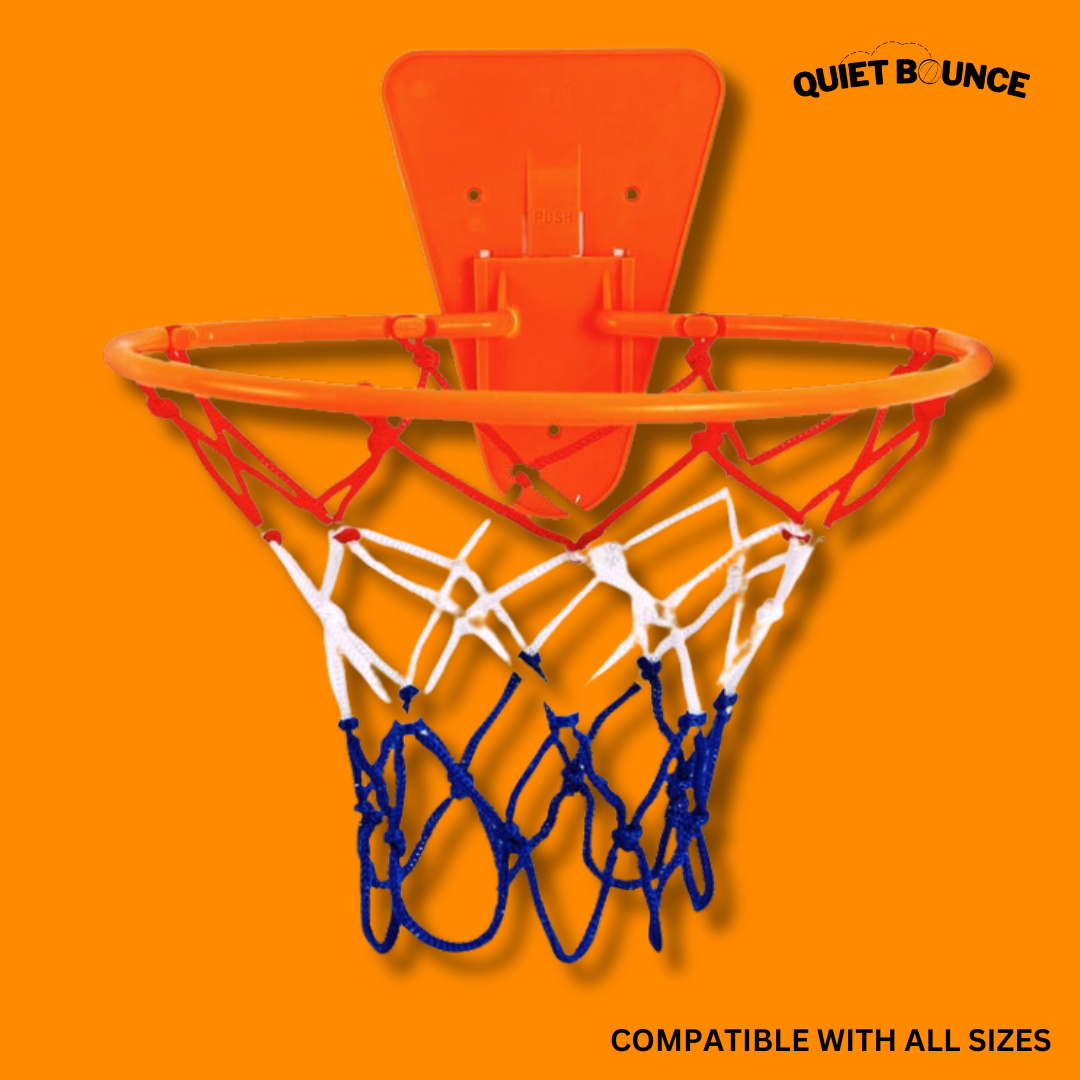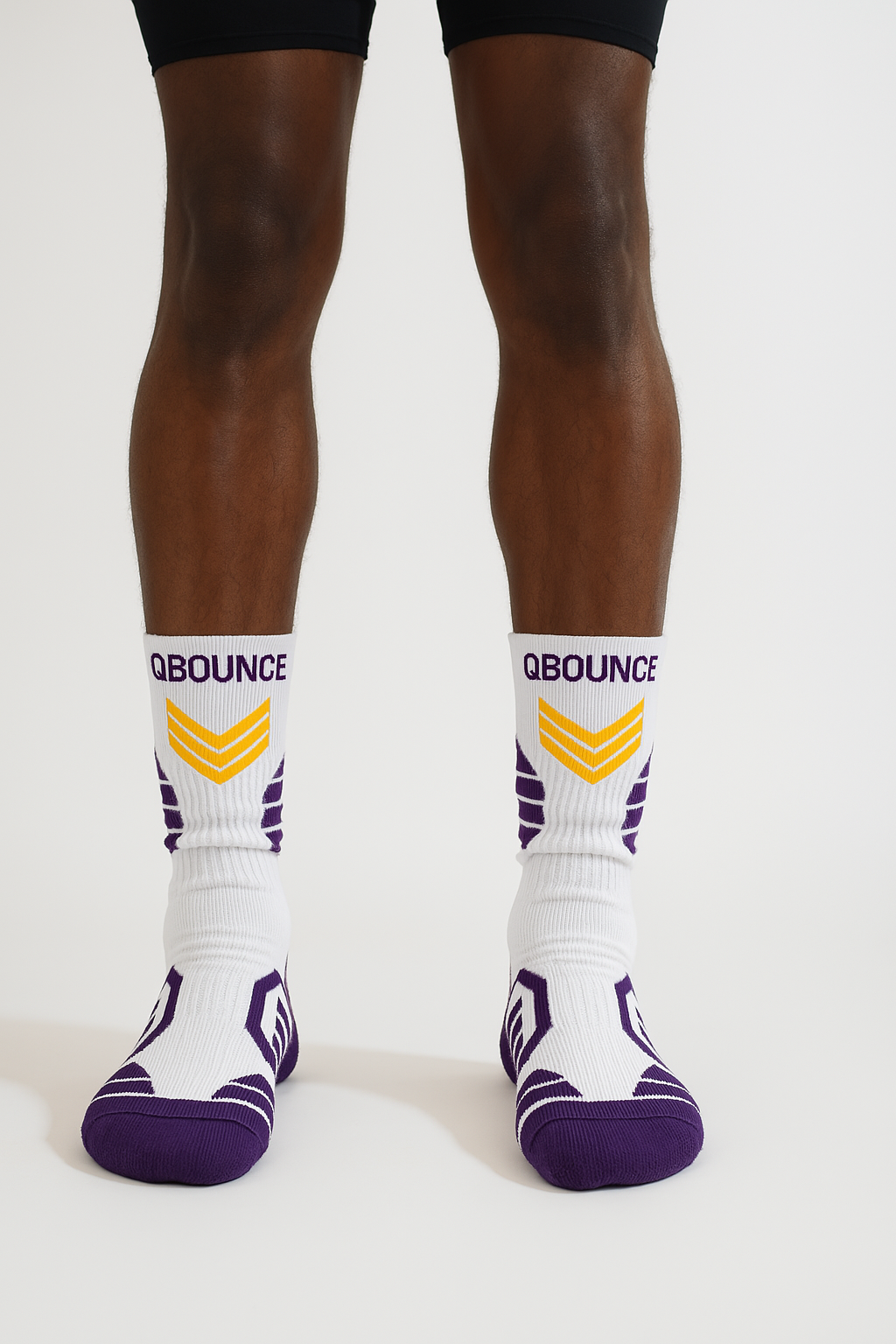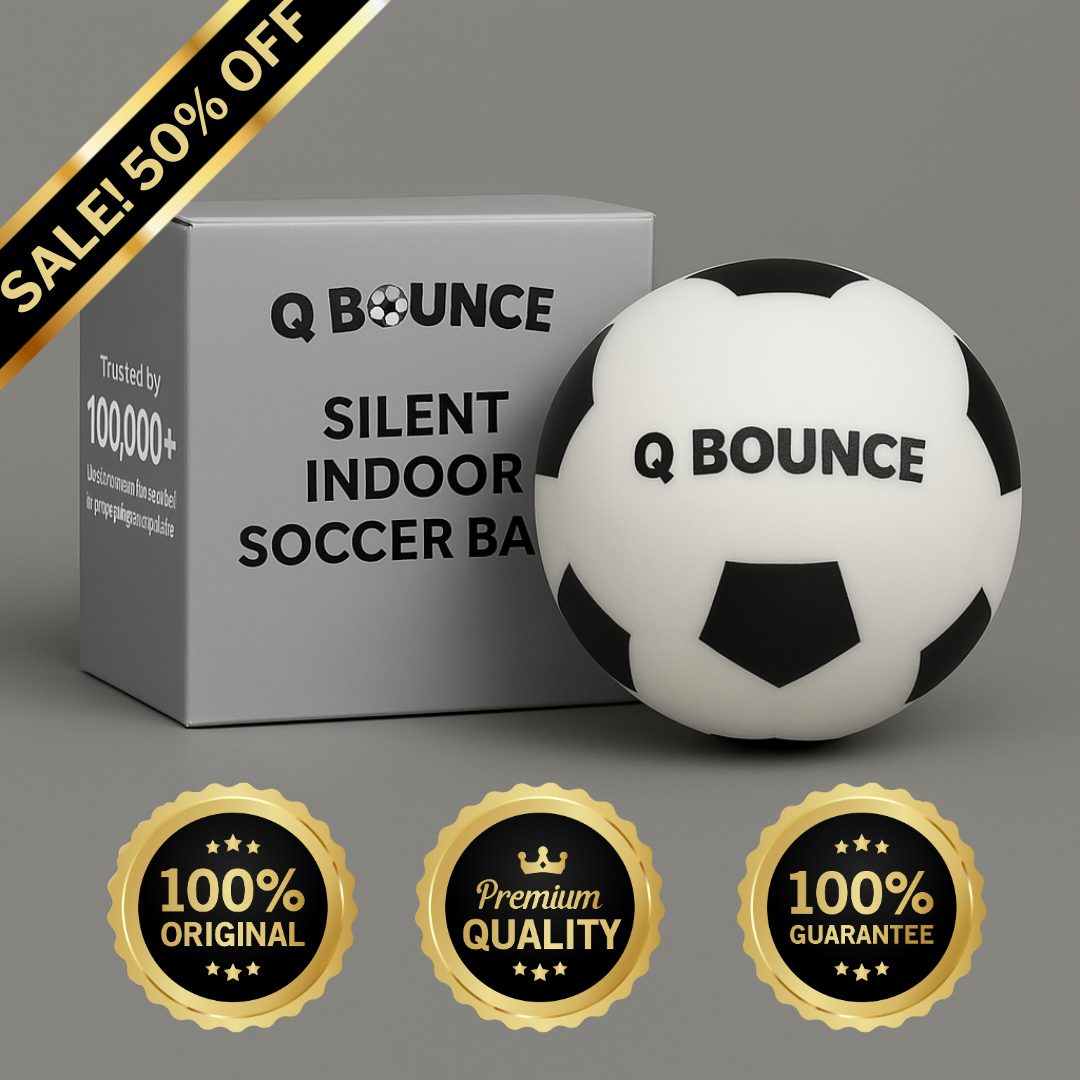
Indoor Basketball vs. Outdoor: Top 5 Factors Every Player Should Consider
Teilen Sie
Picture this: you’re heading to your next game. Will it be the smooth hardwood of an indoor gym or the weathered concrete of your local outdoor court? That choice shapes far more than just your surroundings, it changes how the game feels, how the ball behaves, and even how you execute skills like your power dribble.
From outdoor courts to indoor gyms (or even your living room if you’re using a silent basketball) each setting brings unique advantages. Let’s look at the five biggest factors every player should know before stepping on any court.
Playing Surfaces: Indoor Basketball vs. Outdoor Differences
The ground beneath your sneakers affects every part of your basketball experience. Think about it - the surface isn’t just there passively. It plays a huge role in how the ball bounces, how confidently you can move, and how your entire game flows.
Here’s what you need to know when it comes to indoor basketball vs. outdoor basketball differences.
Indoor Court Characteristics
Walk onto a professional indoor basketball court and you'll notice the contrast immediately. That smooth, consistent surface beneath your feet is engineered for performance.
Most indoor courts feature hardwood flooring, typically crafted from maple, oak, or a combination of both. These polished hardwood floors deliver a smooth, even surface that eliminates those unexpected bounces that can throw off your ball handling.
Recent years have brought synthetic alternatives using materials like polyurethane, vinyl, or acrylic. Rubber surfaces are also gaining popularity due to their durability and easier maintenance requirements.
Here's something many players don't realize: hardwood basketball courts aren't just flat pieces of wood slapped down. They feature multiple layers and specially designed cushioning systems that prevent injury and reduce the strain on your joints.
This advanced construction makes indoor courts significantly more forgiving on your body during those intense games when you're diving for loose balls or landing hard after rebounds.
Outdoor Court Characteristics
Step outside and you're entering a completely different basketball world. Most outdoor courts are built from asphalt or concrete - materials chosen primarily for their ability to withstand whatever nature throws at them.
Among these, asphalt is the most common, offering a balance of toughness and durability.
But there’s another option growing in popularity: multi-purpose plastic or modular tile flooring. These plastic tiles are designed to withstand outdoor conditions while providing better shock absorption and a smoother, more consistent surface. They’re easier on your joints than concrete and often deliver excellent traction, even when wet.
Unlike meticulously maintained indoor floors, outdoor courts often feature cracks, uneven spots, or weather damage that can send the ball bouncing in unexpected directions.
This unpredictability transforms outdoor games into more physical, rugged affairs that reward improvisation and adaptability.
The rougher surface of traditional outdoor courts also changes how easily you can stay balanced or pull off certain moves. Try making a quick pivot or sudden stop on concrete instead of hardwood, and you’ll feel the difference immediately. Add in constant exposure to the elements, and you’ve got surfaces that can become slippery in rain, change ball bounce in extreme heat, or become completely unusable when snow arrives.
Impact of Surface on Ball Bounce
Hard surfaces like concrete absorb less energy compared to softer ones like carpet or cushioned indoor courts. That distinction in energy absorption changes how high the ball bounces.
For example, depending on the specific basketball and surfaces, a ball might bounce about 25 inches high on concrete but only 15 inches high on a softer surface.
Indoor courts provide predictable ball bounce due to their uniform surface, helping you anticipate where the ball will go. Outdoor courts, with their variable textures and occasional imperfections, produce less predictable bounces that make the game more challenging.
Traction and Player Movement
Your ability to move confidently depends heavily on the court surface. Indoor basketball court surfaces typically provide superior traction due to their grip and absence of outdoor elements like dirt or moisture. This enhanced grip allows for quicker movements and more precise direction changes during gameplay.
The texture of indoor surfaces determines how your shoes grip the court, which matters for both agility and injury prevention.
You can move more confidently on indoor courts, knowing the surface will respond consistently to your movements. Outdoor courts present more movement challenges. The stiffness of outdoor surfaces means less impact absorption, leading to added pressure on your joints and increased injury risk.
Key differences between indoor and outdoor basketball court:
-
Indoor courts offer better shock absorption, reducing joint stress
-
Outdoor surfaces are harder on your body due to their rigid materials
-
Indoor courts provide steady traction for quick movements
-
Outdoor courts demand more adaptive footwork, given their variable surfaces
-
Indoor courts allow for more precise, technical movements
Maintenance and Cleanliness
Keeping basketball courts in top shape varies by surface. Indoor courts need daily mopping with a soft mop or scrubber to clear dust, sweat, and spills that can create slippery spots. After heavy use, pros use specialized machines and solutions to deep-clean and restore the floor’s finish. Water and humidity are major threats, potentially warping hardwood.
Outdoor courts need regular sweeping to clear debris and checks for cracks or drainage problems that could affect play or safety. Asphalt courts last longer with routine maintenance and occasional resurfacing.
Even with QBounce’s silent basketball, carpet can swallow up ball movement, while hardwood or tile keeps the ball gliding faster. Knowing how each surface reacts helps you stay sharp when you hit a real court.

Basketball Types
Just like a chef selects the perfect knife for each task, smart basketball players know that indoor and outdoor basketballs are built for completely different purposes. Get this choice right, and you'll see immediate improvements in your ball handling, shooting accuracy, and overall confidence on the court.
What Sets Indoor and Outdoor Basketballs Apart
The engineering behind these basketballs tells the whole story.
Indoor basketballs are crafted to excel on smooth hardwood courts, delivering superior grip and control that lets you execute those crisp crossovers and precise passes. Outdoor basketballs are designed to survive the punishment of asphalt and concrete surfaces.
Not sure which type you're holding?
Try this simple test: bounce it on a hardwood floor. Indoor balls feel softer and grippier, while outdoor balls tend to be firmer and produce a louder sound when dribbled indoors.
Are Outdoor Basketballs Heavier?
Here's something that surprises many players: outdoor basketballs don't actually weigh more than indoor balls of the same size.
That heavier feeling comes from the rubber or composite materials used in outdoor balls, which create a harder, more rigid feel compared to the softer leather of indoor balls.
Official basketball weights are standardized by size, not by indoor/outdoor designation:
-
29.5" (Official/Full Size): 20-22 oz
-
28.5" (Mid/Intermediate Size): 18-20 oz
-
27.5" (Youth Size): 16-18 oz
-
22" (Mini Size): 10.5 oz
The real distinction lies in air pressure. Indoor basketballs usually hold less air, making them lighter and easier to throw. This subtle change alters how the ball responds to your touch, especially during dribbling drills or shooting practice.
Material Composition: Where the Magic Happens
Material choices define how indoor and outdoor basketballs perform on the court.
Indoor basketballs are typically made from:
-
Full-grain leather - Premium Horween leather offers the ultimate playing experience, though it’s slick at first and needs a break-in period.
-
Composite/synthetic leather - These mimic genuine leather’s feel with decent grip and control. They’re more affordable, need less break-in time, and many are suitable for both indoor and outdoor use.
Outdoor basketballs, on the other hand, mostly feature:
-
Rubber - Durable and abrasion-resistant for rough outdoor courts. Rubber balls bounce higher on hard surfaces, need no break-in, and are the most budget-friendly option (as low as $15).
Indoor balls feel softer, smoother, and more cushioned, delivering superior grip and handling. Outdoor balls feel firmer and rougher, prioritizing durability over touch and control.
Many players choose indoor/outdoor or all-surface balls for flexibility. These hybrids strike a balance between durability and feel, perfect for players who split time between indoor gyms, outdoor courts, or QBounce home training.
Environmental Impact
Mother Nature doesn’t take a timeout during your basketball game. Weather conditions shape your performance in ways you might not even realize, influencing everything from your energy levels to how the ball behaves in your hands.
Weather Considerations for Outdoor Play
Playing basketball outdoors means dealing with whatever the weather throws at you. High temperatures above 80°F combined with humidity around 70% can create demanding conditions for your body. When it’s hot and humid, your core temperature rises, and dehydration sets in faster than you might expect.
As the heat intensifies, your muscle endurance drops, forcing your body to shift from aerobic to anaerobic energy systems. This switch means you burn through your energy reserves more quickly than your body can replace them, even if you’re hydrating with sports drinks or eating energy bars.
Research from the American College of Sports Medicine shows that losing just 1-2% of your body weight through sweat can impair speed, coordination, and overall skill performance.
Wind adds another layer of complexity to outdoor games. A crosswind can send your shots off target or push your passes off course. Studies have shown that wind significantly alters ball trajectories in sports like basketball, requiring players to adjust their technique and make split-second decisions.Successful outdoor players learn to read these environmental cues and adapt their game.
Indoor Air Quality and Comfort
Step inside and you escape the weather variables, but indoor environments bring their own considerations.
For optimal performance and health, indoor basketball facilities should maintain relative humidity levels between 40-60%. Unfortunately, many facilities exceed these recommended thresholds.
Good ventilation is the backbone of clean indoor air, pulling fresh air from outside into the gym. It’s especially crucial during basketball games, when heavy breathing ramps up the need for clean air.
Effect of Temperature on Ball Performance
Temperature changes have a major effect on how your basketball behaves. In hot weather, the air inside the ball expands, making it softer and bouncier. In cold conditions, the ball firms up and loses some of its bounce.
For outdoor players, this means the same basketball can feel completely different depending on the season. A ball that’s perfect during spring practice might act unpredictably during a summer heatwave above 90°F.
Indoor environments remove these fluctuations, offering stable conditions ideal for developing skills. This consistency is one reason why players training at home with QBounce equipment often achieve sharper ball handling. A controlled setting allows for more repeatable drills, helping build muscle memory and precision over time.
Seasonal Accessibility of Courts
Year-round availability gives indoor basketball its most obvious advantage. While outdoor courts become unusable during rain, snow, or extreme temperatures, indoor facilities ensure uninterrupted practice regardless of season.
This accessibility factor becomes particularly significant in regions with pronounced seasonal variations. Areas with harsh winters or extreme summer heat might limit outdoor court availability to just a few months annually. Locations like Florida or California offer extended outdoor seasons with ideal playing weather, but most players don't have that luxury.
The consistency of indoor environments allows for uninterrupted skill development - a crucial consideration for players serious about improvement.
Basketball skills require regular practice, and lengthy seasonal interruptions can significantly impact player development.
QBounce training equipment provides a solution for maintaining skills year-round, allowing you to practice consistently regardless of external weather conditions.
When choosing between indoor and outdoor basketball, consider these environmental factors alongside court and ball type. They fundamentally shape your playing experience, performance potential, and practice consistency.
Game Dynamics
The way you play basketball changes completely depending on your court choice. Step from a smooth indoor gym to a rough outdoor court, and you’ll discover that the game itself demands unique skills, strategies, and adaptability from your body and mind.
Understanding indoor basketball vs. outdoor helps you pick the right gear, refine your skills, and adapt your game to any court.
Differences in Gameplay Style
Indoor basketball flows like a well-oiled machine. Games typically follow the standard basketball format with five players adhering to traditional positions and roles.
The controlled environment allows for faster gameplay with more emphasis on three-point shooting and fastbreak opportunities. You can execute plays with precision, knowing the ball will respond predictably to your movements.
Outdoor basketball tells its own story. The pace slows down, not because players want it to, but because the environment demands it. Dribbling is tougher, and weather variables force you to adapt constantly. Point guards find their ball handling skills tested like never before on rougher surfaces. This shift actually gives rebounders and inside scorers a natural advantage over perimeter specialists.
Here's what you'll notice when the game moves indoors or outdoors:
-
Indoor play rewards fluid movement and technical precision
-
Outdoor games favor physical strength and creative problem-solving
-
Perimeter shooters often struggle more in outdoor settings
-
Inside players may find their advantage magnified on outdoor courts
-
Indoor settings allow for more consistent team strategy execution
Ball Control and Grip
Indoor courts provide that smooth, even surface that makes dribbling feel effortless, especially for beginners. This consistency directly translates to better ball handling and fewer turnovers.
The improved grip that comes with indoor basketballs creates a noticeable boost in offensive performance. Combined with the superior foot traction of indoor courts, you'll find yourself making quicker movements and more confident direction changes.
Outdoor basketball tests your body and skills more intensely. The harsher conditions require greater physical strength and energy. When you combine rougher court surfaces with outdoor basketballs that offer less grip, ball control becomes a genuine challenge that forces you to adapt your entire dribbling technique.

Popularity of Indoor Basketball vs. Outdoor Basketball Games
Outdoor courts draw players for casual play and pickup games because of their accessibility. Meanwhile, indoor courts dominate organized competition from high school leagues all the way to the NBA.
Your preference often depends on what you experienced during your early basketball years.
Silent basketball and training mat help apartment-dwellers practice fundamental skills that transfer seamlessly between settings.
Injury Risks
Your body instantly notices the contrast between playing surfaces.
Indoor basketball courts feature shock-absorbing materials that ease stress on your joints, helping reduce injuries from repetitive impacts.
Outdoor courts made of concrete or asphalt place much greater strain on your knees and other joints.
Common indoor basketball injuries include ankle sprains from quick direction changes, knee pain from frequent jumping, and wrist injuries from falls. Repeated jumping on hard surfaces can also contribute to stress fractures over time.
Recognizing these differences helps you tailor your training and protect your body, no matter where you play.
Choosing the Right Setting
So, which court is calling your name? Now that you’ve seen how indoor and outdoor basketball each bring their own vibe, think about your goals, your budget, and where you’ll be playing most often. Choosing the right spot can seriously level up your skills and confidence.
Can You Use an Outdoor Basketball Indoors?
Sure, you can take an outdoor basketball inside, but it's not always your best bet. The rough rubber surface doesn't grip those smooth hardwood floors nearly as well as a composite basketball, which means your dribbling and shooting won't feel as controlled.
Plus, outdoor balls often carry dirt from concrete or asphalt courts, potentially making indoor surfaces slippery and affecting your traction. While an outdoor ball won’t damage an indoor court, it might leave you playing below your best.
Can You Use an Indoor Basketball Outside?
Technically, yes, but here's why you probably shouldn't. Indoor basketballs, especially full-grain leather ones, can take a beating when you use them on rough outdoor surfaces. Even bouncing an indoor ball on pavement while you're walking to the court can cause significant damage.
Best Ball for Mixed-Use Players
Are you the type of player who hits both indoor gyms and outdoor courts? Weighted basketballs are great for building strength and improving ball control because the extra weight forces your hands and arms to work harder.
Age and Skill Level Considerations
Your basketball should match where you are in your basketball journey. Younger players benefit from appropriately sized balls that help develop proper shooting techniques.
As your skills improve, you might gravitate toward the superior feel of indoor balls, perfect for progressing from basketball dribbling drills for beginners to more advanced handling techniques.
Your choice ultimately depends on your primary playing environment, budget constraints, and personal preferences. Whether you're practicing with QBounce equipment at home or hitting the courts with friends, the right basketball can help you develop the skills and confidence you need to keep improving your game.
Conclusion
Think about your own basketball goals. When considering indoor basketball vs. outdoor, ask yourself where you’ll play most often and what conditions help you improve. Indoor courts give you that controlled environment where you can focus on perfecting your form without worrying about wind or uneven surfaces disrupting your dribbling rhythm.
Or maybe you're drawn to the raw, adaptive challenge of outdoor basketball. Those concrete courts teach you resilience - how to adjust your game when conditions aren't perfect, how to maintain control when the ball takes an unexpected bounce, how to stay focused when the elements test your determination.
For those practicing at home with QBounce equipment, these insights become even more valuable. You can develop foundational skills in your apartment that transfer seamlessly to any court - indoor or outdoor.
Silent basketballs and training mats let you build the consistency and muscle memory that will serve you whether you're playing on pristine hardwood or weathered asphalt.
The best basketball players adapt to any environment. They understand that each setting offers unique lessons that ultimately make them more complete players. Your journey might start on one type of court, but embracing both worlds will expand your skills and deepen your love for the game.
So grab your basketball and get out there. Time to put these insights into action.
Frequently Asked Questions (FAQ)
-
What is the difference between indoor and outdoor basketball?
Indoor basketballs are typically made of leather or composite materials, providing better grip and control on smooth surfaces. Outdoor basketballs are made of more durable rubber to withstand rough outdoor courts. Indoor balls are softer and more expensive, while outdoor balls are harder and more affordable.
-
How does the playing surface affect basketball performance?
Indoor courts offer smoother, more consistent surfaces that allow for better ball control and more predictable bounces. Outdoor courts, often made of concrete or asphalt, have variable textures and imperfections that can lead to unpredictable ball behavior, requiring players to adapt their skills.
-
Is it harder to play basketball outdoors?
Yes, outdoor basketball can be more challenging due to environmental factors like wind, variable temperatures, and uneven court surfaces. These conditions can affect ball trajectory, player movement, and overall game dynamics, making outdoor play more physically demanding and unpredictable.
-
Can you use an outdoor basketball indoors?
While it's possible to use an outdoor basketball indoors, it's not ideal. Outdoor balls can bring in dirt, which reduces traction on indoor courts. They also don't provide the same grip and responsiveness as indoor basketballs on smooth surfaces, potentially impacting gameplay quality.
-
Can I use an indoor basketball outside?
Technically, yes, but it’s not recommended. Full-grain leather indoor balls can quickly wear out on outdoor surfaces like concrete or asphalt. Even bouncing an indoor ball on pavement while heading to the court can scuff and damage it, reducing lifespan and performance.
-
How do indoor and outdoor basketball environments impact player health?
Indoor courts generally offer better shock absorption, reducing stress on players' joints. Outdoor courts, especially those made of concrete, can place more strain on knees and other joints. However, indoor facilities require proper ventilation and humidity control to maintain optimal air quality for player health and performance.
-
Is it worth owning both an indoor and outdoor basketball?
For serious players, yes. Using the right ball for the right environment helps maintain your equipment and ensures you’re practicing under realistic conditions. An indoor ball offers better touch and control, while an outdoor ball is built to last on rough surfaces.
-
How can I practice basketball indoors without making noise?
Use a silent basketball like QBounce and a training mat. These tools let you work on dribbling, footwork, and ball handling without disturbing neighbors or family members. They’re perfect for apartments or houses where noise is a concern.




